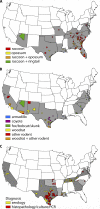Trypanosoma cruzi and Chagas' Disease in the United States
- PMID: 21976603
- PMCID: PMC3194829
- DOI: 10.1128/CMR.00005-11
Trypanosoma cruzi and Chagas' Disease in the United States
Abstract
Chagas' disease is caused by the protozoan parasite Trypanosoma cruzi and causes potentially life-threatening disease of the heart and gastrointestinal tract. The southern half of the United States contains enzootic cycles of T. cruzi, involving 11 recognized triatomine vector species. The greatest vector diversity and density occur in the western United States, where woodrats are the most common reservoir; other rodents, raccoons, skunks, and coyotes are also infected with T. cruzi. In the eastern United States, the prevalence of T. cruzi is highest in raccoons, opossums, armadillos, and skunks. A total of 7 autochthonous vector-borne human infections have been reported in Texas, California, Tennessee, and Louisiana; many others are thought to go unrecognized. Nevertheless, most T. cruzi-infected individuals in the United States are immigrants from areas of endemicity in Latin America. Seven transfusion-associated and 6 organ donor-derived T. cruzi infections have been documented in the United States and Canada. As improved control of vector- and blood-borne T. cruzi transmission decreases the burden in countries where the disease is historically endemic and imported Chagas' disease is increasingly recognized outside Latin America, the United States can play an important role in addressing the altered epidemiology of Chagas' disease in the 21st century.
Figures




References
-
- AABB Chagas Biovigilance Network 2011, posting date Reports through 04/18/2011. http://www.aabb.org/programs/biovigilance/Pages/chagas.aspx
-
- Abad-Franch F., Monteiro F. A. 2007. Biogeography and evolution of Amazonian triatomines (Heteroptera: Reduviidae): implications for Chagas disease surveillance in humid forest ecoregions. Mem. Inst. Oswaldo Cruz 102(Suppl. 1):57–70 - PubMed
-
- Acquatella H. 2007. Echocardiography in Chagas heart disease. Circulation 115:1124–1131 - PubMed
-
- Aguilar H. M., Abad-Franch F., Dias J. C., Junqueira A. C., Coura J. R. 2007. Chagas disease in the Amazon region. Mem. Inst. Oswaldo Cruz 102(Suppl. 1):47–56 - PubMed
-
- Altclas J., et al. 2005. Chagas disease in bone marrow transplantation: an approach to preemptive therapy. Bone Marrow Transplant. 36:123–129 - PubMed
Publication types
MeSH terms
LinkOut - more resources
Full Text Sources
Other Literature Sources
Medical
Research Materials

